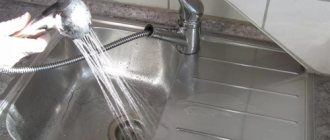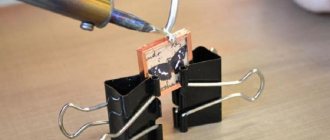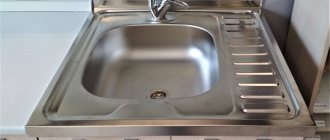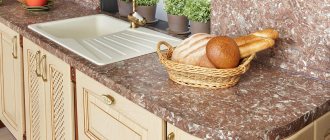The furniture manufacturing industry provides a huge number of different kitchen furniture to choose from. Sometimes a dishwasher is offered separately and is installed by the buyer independently. This does not require any special knowledge or skills.
If the sink is purchased separately and requires installation, it is advisable to entrust this work to professionals.
To make a hole correctly, you need the simplest tool. The question of how to cut a countertop for a sink is not very difficult. However, if you do not follow certain installation requirements, the installed equipment can be damaged.
The sequence and manipulations performed are similar to cutting a hole in chipboard.
To make a hole correctly, you need the simplest tool.
The location for the cutout is selected taking into account the minimum distance for draining water into the sewer and connecting the water supply.
It is better to do this outdoors, as there will be a lot of dust during the sawing process.
The sink can be installed relative to the level of the working surface in the following ways.
- Below the table top. This arrangement looks very impressive, but will additionally require the use of a special tool. The sink itself must have a certain shape. In this case, it is attached from below using special fasteners. They are usually sold as a set. The open end must be impregnated with a water-repellent agent. At the same time, it must have sufficient thickness.
- On the same level. In this situation, it is very important to correctly make the required recess equal to the thickness of the side. It should be perfect around the entire perimeter of the sink being installed.
- Above tabletop level. For this type of installation you need the simplest tool. No special effort is required for this installation.
You will need to wear protective gloves on your hands, and protect your face with a special transparent mask.
Sometimes a dishwasher is offered separately and is installed by the buyer independently.
Necessary materials
The sealant is used to prevent moisture from entering the areas of contact between the sink and the countertop. Water can greatly damage chipboard. There is a different sealant for different surfaces. When working with artificial stone, only silicone is used. Sealants containing alcohol are more often used for wood and plastic.
If you decide to cut a hole in the countertop for the sink yourself, you will need a special tool - a grinder with a diamond wheel.
Using a sealant not only prevents unwanted water penetration. This also serves as additional strength to the connection.
If the sink is purchased separately and requires installation, it is advisable to entrust this work to professionals.
Required tools:
- electric drill
- electric jigsaw
- wood drill with a diameter of 10 mm.
- set of wrenches
- brush
- adjustable wrench
- rasp
- screwdriver
When purchasing kitchen furniture with such a surface, it is advisable to have a ready-made product that will only require connection to the water supply and sewerage system.
Before cutting a hole in the countertop for the sink, mark the required hole. To do this, a template is made from cardboard or thick paper. Some manufacturers and manufacturers of sinks include a template with the product itself. If you have chosen the option of installing on a tabletop and the sides are of sufficient width, you can mark without a template. For this, the sink is used as a template. The upper surface is applied to the plane and traced along the contour with a marker or pencil. For ease of installation, it is advisable to remove the tabletop. Having stepped back 0.5 - 1 cm from the drawn line, a working contour is drawn along which the cut is made.
It will look more solid, but it will be more difficult to install a sink into it yourself.
Having marked the cut line, the template is removed and you can begin the process of cutting out the place for washing. A drill is used to drill a place for an electric jigsaw file, approximately 10 mm in diameter. For a quadrangular or triangular sink, holes are made in all corners. If the product has a round or oval shape, one will be enough for the job.
Installing a sink in a countertop made of wood or chipboard is not difficult if you have the required tools and basic handling skills.
The hole and cut are made from the side of the laminate, this will prevent it from chipping. Use a jigsaw to carefully cut out the required hole along the drawn contour. The electric jigsaw must be pressed firmly against the surface. The saw blade should go exactly at a right angle.
The sink is covered with a sealing tape supplied with the product.
The inner part being cut must be supported while doing this work. Or position the tabletop so that when cutting is completed, this part does not fall. If the remaining and removable parts are abruptly separated, the laminated coating may crack. Or a part will break off from the chipboard.
You can use a drill with a special drill - a furniture crown, just immediately take a drill of the required diameter.
If there is no room for such an arrangement, or the tabletop has not been removed, use construction tape. Sawing is done in this case with stops. A 10-15 cm cut is made, which is then taped on both sides.
A drain and, if provided for by the design, a mixer (water tap) are mounted to the bowl.
After the cutting is completed, the sink is first tried on. It should fit freely, but the gap should not be large. If it fits too tightly, you should widen the installation site with a rasp or jigsaw.
Having marked the cut line, the template is removed and you can begin the process of cutting out the place for washing.
Now you should carefully “sand” the inner end to which the sink will adjoin. This is done with fine-grit sandpaper. The resulting dust is removed, and a thin layer of sealant is applied to the contact area using a brush.
For ease of installation, it is advisable to remove the tabletop.
Nuances of chipboard processing
First of all, let's look at all the materials and tools that will be needed for the job:
- the laminated chipboard itself;
- pre-sharpened blade;
- jigsaw;
- ordinary jigsaw.
By the way, chipboard in the furniture industry and construction began to be used only in 1940 in the United States of America, but after a fairly short time the popularity of this material increased and spread throughout the world. Thanks to this, the industry has made a significant step forward, and all sorts of varieties of this material have appeared.
One of the most popular and frequently used types is laminated chipboard, which is not just a product of pressing sawdust with glue, susceptible to high temperatures, but also acts as an additional chemical and physical protection in the form of a melamine film.
Usually, when cutting chipboard, no complications arise, but with laminated chipboard, this seemingly simple process can become complicated. The fact is that countertops are often coated with multilayer HPL plastic from the manufacturer. This significantly complicates the sawing process. This coating can vary significantly in quality and basic properties, and it is not always a polymer coating. Therefore, when processing this material, many different nuances arise.
Step-by-step description of the process itself:
- Using a well-sharpened blade, a groove 2-3 mm deep is made. If there is a polymer coating of various types, it is recommended to slightly warm up the blade, and then immediately begin direct use. Due to the resulting pressure of cold steel on hard plastic, even if the sharpening is very good, minor microcracks and chips may occur, which is best avoided if possible.
- Using a tool called a jigsaw, you need to make the cut carefully and smoothly. During operation, it is important to carefully adjust the direction of the blade. If there are places where the direction changes, it is better to use an ordinary hand jigsaw as a secondary, auxiliary tool. Or you can use the thinnest file in a jigsaw. But this is not always convenient.
After the work has been done, you can proceed to the final stage of sawing the chipboard.
Installation of sink and connection of communications
A drain and, if provided for by the design, a mixer (water tap) are mounted to the bowl. All gaskets are installed in the required sequence. Typically, the layout of the gaskets is indicated by the manufacturer on the packaging of the mixer and drain siphon. Threaded connections can be easily tightened using wrenches or, if necessary, an adjustable wrench.
When purchasing kitchen furniture with such a surface, it is advisable to have a ready-made product that will only require connection to the water supply and sewerage system.
If the structure on which installation is planned does not have holes for water supply and sewerage, they should be cut out. They are done in the same way as for washing. It is drilled with a drill and an opening of the required size is cut out with an electric jigsaw. You can use a drill with a special drill - a furniture crown, just immediately take a drill of the required diameter.
For this, the sink is used as a template.
The sink is covered with a sealing tape supplied with the product. A small gap is left from the edge, which is subsequently filled with sealant. Fastenings are being installed.
Some manufacturers and manufacturers of sinks include a template with the product itself.
Reapply the sealant to the contact areas and let it dry a little, 2-3 minutes. Place the product in place and tighten the fasteners. Secure the tabletop together with it in its place and connect the water hoses. Connect the drain. Once again, go over the joints with sealant, the excess must be removed.
Before cutting a hole in the countertop for the sink, mark the required hole.
How to treat a stone countertop?
Most often, the manufacture of slabs made of polymer or natural stone is ordered to match the sink that has already been selected. If this has not been done, you will have to cut a hole using a grinder with a concrete disc.
Do-it-yourself marking operations are carried out in the same way as for wooden varieties.
Installing a stone sink
For granite and polymer products, you will have to cut out the hole for the siphon yourself, using a drill with a cutter with a diameter of 5 cm. Installing an artificial stone sink under the countertop is not too difficult:
- When the recess to the size of the sink is ready, the countertop is turned inside out. The sink is turned over and the outer contours of the side are marked around the hole.
- According to the markings, select a groove into which you want to recess the edges of the bowl. You need to select a part of the array in several stages, trying on and adjusting the sink.
- The edges of the recess are polished and treated with isopropyl alcohol. Dry and apply silane-based glue, filling the groove so that the glue is slightly squeezed onto the surface. The excess is immediately removed, and the parts to be joined are tightened with clamps and left for 12 hours to set (unless the instructions for the glue indicate a different time).
- Fill the edges of the sink with a two-component compound (epoxy) and leave until hardened. After drying, level the surface, removing all sagging.
After connecting the bowl and countertop, attach the mixer and siphon, place the stove with sink on the cabinets and fix it to the base of the set. Connect the sink to communications.
Installing a sink in a structure made of other materials
Installing a sink in a countertop made of wood or chipboard is not difficult if you have the required tools and basic handling skills. A countertop made of artificial or natural stone installed in the food preparation area will be more durable. It will look more solid, but it will be more difficult to install a sink into it yourself.
The use of sealant not only prevents unwanted water penetration
When purchasing kitchen furniture with such a surface, it is advisable to have a ready-made product that will only require connection to the water supply and sewerage system.
Sealants containing alcohol are more often used for wood and plastic.
If the sink is purchased separately and requires installation, it is advisable to entrust this work to professionals. In a stone processing workshop, craftsmen will perform the required work without damaging the surface. To do this, they have the appropriate skills and have the entire set of necessary tools.
There is a different sealant for different surfaces.
If you decide to cut a hole in the countertop for the sink yourself, you will need a special tool - a grinder with a diamond wheel. Great care is required when working with this tool. You will need to wear protective gloves on your hands, and protect your face with a special transparent mask.
The sealant is used to prevent moisture from entering the areas of contact between the sink and the countertop.
It is better to do this outdoors, as there will be a lot of dust during the sawing process. The sequence and manipulations performed are similar to cutting a hole in chipboard.
The location for the cutout is selected taking into account the minimum distance for draining water into the sewer and connecting the water supply.
What tools to use?
If the question arises of how to cut a tabletop, then first of all you need to decide on a cutting tool, and most often several tools are used.
For example, using a circular saw, you can get the perfect result, but this is quite an expensive pleasure, because a high-quality tool costs a lot of money. Therefore, this unit can be found mainly only in special factories.
Grinder - has similarities with the previous tool, but the result will be far from ideal. When working with an angle grinder, many chips may form.
Usually, to cut a tabletop, two main professional and interchangeable tools are used - a jigsaw and a jigsaw.
Construction specialists divide blades or, as they are also called, saws into two main categories:
- tearing little by little on both sides;
- tearing strongly, but only on one side.
When working with a tabletop, you will need the option that breaks on one side.
Before starting the main work, it is necessary to thoroughly sharpen the blade of the tool so that chips do not form during the work. With a sharpened blade, before you start cutting the material directly, you need to make a groove, the depth of which will be about 2-3 mm. This will make it possible to complete the job without injuries or chips.
Fraser
The milling cutter allows you to get the cleanest possible edge of the workpiece, while the quality will not be so easy to distinguish from the formatter, and sometimes it will be even better.
First, you need to cut the workpiece with a jigsaw, making an indentation from the marking line by 2-3 mm, and then align the line according to the template. Usually, for this purpose, a second piece of laminated chipboard is used, sawn on a format saw, so that it is of a suitable size.
It is necessary to use a copy cutter, that is, one with a bearing. This way you can get a very clean cut. Among the disadvantages of working with a router, there is a lot of hassle, since there is a need for precise markings, preliminary filing of workpieces and setting templates for the router.
Final stage
At the final stage, it is necessary to use another tool. To do this you will need a rasp or file, sandpaper, GOI posts, adhesive tape and a decorative corner made of duralumin.
The first step is to sand the wood. For this purpose, you can use a rasp or file, with which you want to remove excess. After this, use a sanding machine or regular sandpaper (zero grade will do) to bring the wood into a nice looking state. It is recommended to carry out this work even if you are not going to do anything after it. Due to the torn elements of the wood, the material will attract moisture much faster, which will cause faster wear of the material.











